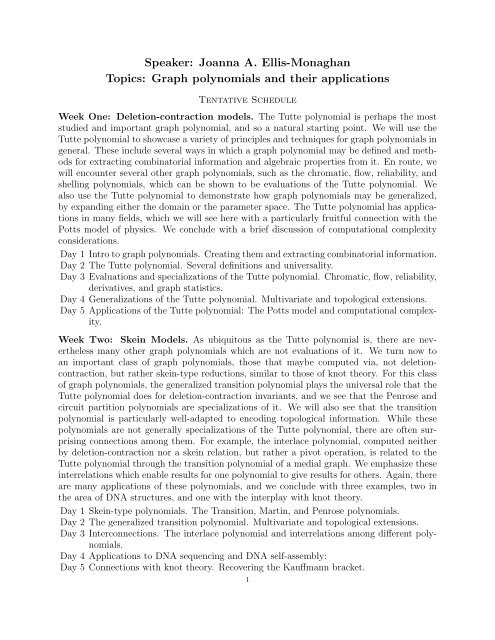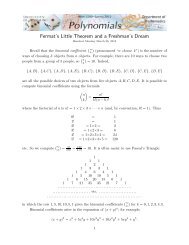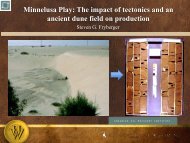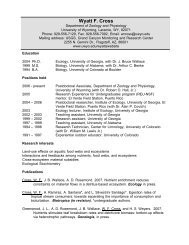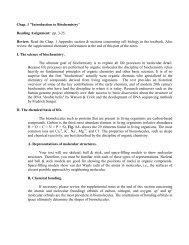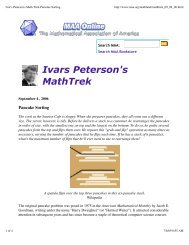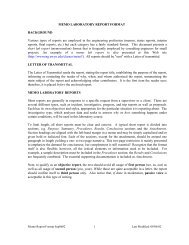Graph polynomials and their applications
Graph polynomials and their applications
Graph polynomials and their applications
You also want an ePaper? Increase the reach of your titles
YUMPU automatically turns print PDFs into web optimized ePapers that Google loves.
Speaker: Joanna A. Ellis-Monaghan<br />
Topics: <strong>Graph</strong> <strong>polynomials</strong> <strong>and</strong> <strong>their</strong> <strong>applications</strong><br />
Tentative Schedule<br />
Week One: Deletion-contraction models. The Tutte polynomial is perhaps the most<br />
studied <strong>and</strong> important graph polynomial, <strong>and</strong> so a natural starting point. We will use the<br />
Tutte polynomial to showcase a variety of principles <strong>and</strong> techniques for graph <strong>polynomials</strong> in<br />
general. These include several ways in which a graph polynomial may be defined <strong>and</strong> methods<br />
for extracting combinatorial information <strong>and</strong> algebraic properties from it. En route, we<br />
will encounter several other graph <strong>polynomials</strong>, such as the chromatic, flow, reliability, <strong>and</strong><br />
shelling <strong>polynomials</strong>, which can be shown to be evaluations of the Tutte polynomial. We<br />
also use the Tutte polynomial to demonstrate how graph <strong>polynomials</strong> may be generalized,<br />
by exp<strong>and</strong>ing either the domain or the parameter space. The Tutte polynomial has <strong>applications</strong><br />
in many fields, which we will see here with a particularly fruitful connection with the<br />
Potts model of physics. We conclude with a brief discussion of computational complexity<br />
considerations.<br />
Day 1 Intro to graph <strong>polynomials</strong>. Creating them <strong>and</strong> extracting combinatorial information.<br />
Day 2 The Tutte polynomial. Several definitions <strong>and</strong> universality.<br />
Day 3 Evaluations <strong>and</strong> specializations of the Tutte polynomial. Chromatic, flow, reliability,<br />
derivatives, <strong>and</strong> graph statistics.<br />
Day 4 Generalizations of the Tutte polynomial. Multivariate <strong>and</strong> topological extensions.<br />
Day 5 Applications of the Tutte polynomial: The Potts model <strong>and</strong> computational complexity.<br />
Week Two: Skein Models. As ubiquitous as the Tutte polynomial is, there are nevertheless<br />
many other graph <strong>polynomials</strong> which are not evaluations of it. We turn now to<br />
an important class of graph <strong>polynomials</strong>, those that maybe computed via, not deletioncontraction,<br />
but rather skein-type reductions, similar to those of knot theory. For this class<br />
of graph <strong>polynomials</strong>, the generalized transition polynomial plays the universal role that the<br />
Tutte polynomial does for deletion-contraction invariants, <strong>and</strong> we see that the Penrose <strong>and</strong><br />
circuit partition <strong>polynomials</strong> are specializations of it. We will also see that the transition<br />
polynomial is particularly well-adapted to encoding topological information. While these<br />
<strong>polynomials</strong> are not generally specializations of the Tutte polynomial, there are often surprising<br />
connections among them. For example, the interlace polynomial, computed neither<br />
by deletion-contraction nor a skein relation, but rather a pivot operation, is related to the<br />
Tutte polynomial through the transition polynomial of a medial graph. We emphasize these<br />
interrelations which enable results for one polynomial to give results for others. Again, there<br />
are many <strong>applications</strong> of these <strong>polynomials</strong>, <strong>and</strong> we conclude with three examples, two in<br />
the area of DNA structures, <strong>and</strong> one with the interplay with knot theory.<br />
Day 1 Skein-type <strong>polynomials</strong>. The Transition, Martin, <strong>and</strong> Penrose <strong>polynomials</strong>.<br />
Day 2 The generalized transition polynomial. Multivariate <strong>and</strong> topological extensions.<br />
Day 3 Interconnections. The interlace polynomial <strong>and</strong> interrelations among different <strong>polynomials</strong>.<br />
Day 4 Applications to DNA sequencing <strong>and</strong> DNA self-assembly:<br />
Day 5 Connections with knot theory. Recovering the Kauffmann bracket.<br />
1
A sample range of questions related to this topic<br />
Big questions. These are known to be more or less NP-hard in the most general case,<br />
but there are many, many special variations to consider. People have made careers out of<br />
investigating these area.<br />
• Find exact solutions to the Tutte/Potts model for various lattices <strong>and</strong> various models.<br />
• Determine conditions for sequence reconstruction with various levels of data.<br />
Focused open questions. These questions are easy to state, but they have been open for<br />
a while.<br />
• Show that the U (or W) polynomial is a complete invariant of trees (or even at least<br />
caterpillars).<br />
• Prove that P(G;-1) is non-zero for plane graphs.<br />
• Do the coefficients of the Penrose polynomial alternate in sign?<br />
Straightforward exercises. These are known results, more or less on the level found in a<br />
typical graduate text.<br />
• Find formulas for the chromatic polynomial for common classes of graphs (paths,<br />
cycles, complete graphs, etc.)<br />
• Prove that the reliability polynomial is a specialization of the Tutte polynomial<br />
• Compute the Potts model for a small grid, <strong>and</strong> use it to find the probability of a<br />
monochromatic state.<br />
A partial list of resources for the course<br />
[1] L. Beaudin*, J. Ellis-Monaghan, G. Pangborn, R. Shrock, A little statistical mechanics for the graph<br />
theorist, Discrete Mathematics, 310 (13-14) 2010, 2037-2053.<br />
[2] Bollobas, B.: Modern <strong>Graph</strong> Theory, Graduate Texts in Mathematics. Springer, 1082 New York (1998)<br />
[3] Brylawski, T., Oxley, J.: The Tutte polynomial <strong>and</strong> its <strong>applications</strong>. In: White, 1097 N. (ed) Matroid<br />
Applications, Encyclopedia of Mathematics <strong>and</strong> its Applica- 1098 tions. Cambridge University Press,<br />
Cambridge (1992)<br />
[4] J. Ellis-Monaghan, C. Merino, <strong>Graph</strong> <strong>polynomials</strong> <strong>and</strong> <strong>their</strong> <strong>applications</strong> I: the Tutte polynomial, invited<br />
chapter for Structural Analysis of Complex Networks, Matthias Dehmer, ed., Birkhauser, 2010.<br />
[5] J. Ellis-Monaghan, C. Merino, <strong>Graph</strong> <strong>polynomials</strong> <strong>and</strong> <strong>their</strong> <strong>applications</strong> II: interrelations <strong>and</strong> interpretations,<br />
invited chapter for Structural Analysis of Complex Networks, Matthias Dehmer, ed., Birkhauser,<br />
2010.<br />
[6] J. Ellis-Monaghan, I. Moffatt, <strong>Graph</strong>s on Surfaces: Twisted Duality, Polynomials, <strong>and</strong> Knots. Invited<br />
monograph for the Springer Briefs Series, submitted<br />
[7] J. Ellis-Monaghan, I. Moffatt, A Penrose polynomial for embedded graphs, in press, European Journal<br />
of Combinatorics.<br />
[8] J. Ellis-Monaghan, G. Pangborn, Using DNA self-assembly design strategies to motivate graph theory<br />
concepts, Math. Model. Nat. Phenom., 6, no. 6 (2011) 96-107.<br />
[9] Sokal, A. D.: Chromatic <strong>polynomials</strong>, Potts models <strong>and</strong> all that. Physica A, 1319 279, 324332 (2000)<br />
[10] Sokal, A. D. A personal list of unsolved problems concerning lattice gases <strong>and</strong> antiferromagnetic Potts<br />
models. Markov Process Relat. Fields, 7, 21-38 (2001).<br />
[11] Welsh, D. J. A., Merino, C.: The Potts model <strong>and</strong> the Tutte polynomial. J. 1304 Math. Phys., 41,<br />
11271152 (2000)<br />
[12] Welsh, D. J. A.: Complexity: Knots, Colorings <strong>and</strong> Counting, Cambridge University Press, Cambridge<br />
(1993).<br />
2


